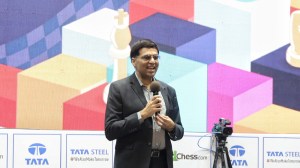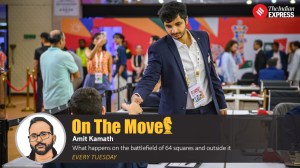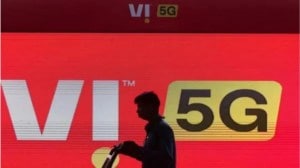Criticism for India contingent’s Olympics outfit: How it was chosen, what the designer said
The outfit has been bashed on social media, for being "tacky" and not doing justice to India’s traditional weaving traditions. Here is how it was chosen and what designer Tarun Tahiliani said about the design.
 Indian athletes wave the national flags from a boat on the Seine River during the opening ceremony of the Paris 2024 Olympic Games, in Paris, France, Friday, July 26, 2024. (PTI Photo/Ravi Choudhary)
Indian athletes wave the national flags from a boat on the Seine River during the opening ceremony of the Paris 2024 Olympic Games, in Paris, France, Friday, July 26, 2024. (PTI Photo/Ravi Choudhary) The social media blitz over the uniform of the Indian contingent at the Olympics — with reactions ranging from its “tacky” and underwhelming look to an “injustice” to Indian weaving traditions and motifs — focuses on the need for putting more thought and time into making sporting attire an extension of brand India.
But how are the designs chosen? We explain.
So who decides on the design for a uniform?
This works as a partnership between the Indian Olympic Committee (IOC) and the designer/design house, who is contracted after a fair bid. The selection process factors in both the financial and creative aspects of the agency.
The aspirant agency should be qualified enough to create a visual motif that can strengthen brand India and at the same time have enough money and resources to execute it. That’s why every design house and sportswear brand vies for this contract with their respective country Olympic committees around the world. This is the first time that the uniform for Team India was entrusted to a designer — Tarun Tahiliani via Tasva, the premium affordable menswear label launched by him and Aditya Birla Fashion and Retail Limited.
Many couture brands feature in the Paris Olympic 2024 list of uniform-makers, including Ralph Lauren for the United States, Berluti for France and Emporio Armani for Italy.
Has a designer been given the contract for the Olympic team uniform before?
So far, the dress code has just been sari, salwar suits, suits, bandhgalas, turbans and blazers for athletes. The Government has so far used designers for uniforms of the national carrier, Air India, and khadi promotion.
What are considerations for clearing a design?
According to Tahiliani, “A designer has to follow a set of guidelines put out by the Indian Olympic Committee (IOC). The team has to factor in the colours of the tricolour as most countries follow their flag because that’s all that is visible from afar. The current design was chosen by a vetting committee from multiple sketches and multiple options.”
There was a lot of to and fro, according to Tahiliani, who was present at most of those feedback interactions, amendments and fittings for the 300-member squad of athletes and officials. “Many things got changed at the last minute. I would do it again with a little more colour as we saw the athletes from far away,” he added.
Why has Tarun Tahiliani come under criticism?
That’s because smaller nations like Mongolia and Sri Lanka have created more thoughtful and representative designs that many feel reflect their handcrafted traditions and culture better.
Mongolia featured embroideries with birds for freedom, mountains as a nod to the nation’s landscapes and hard work, gold and silver accents for a touch of elegance and the Mongolian national colours of blue, red and white. Sri Lanka’s white garments use silk, handmade embroidery, and beadwork to represent the looks of the royal courts of the 19th century.
The criticism around Tahiliani was that he used cotton instead of silk, did not use weaves or embroideries and chose digital ikat prints instead, which some interpreted as an insult to our handloom and handcrafting traditions.
Of course, even designers like Ralph Lauren and Armani have been criticised for making bland designs compared to smaller nations who seem to have taken their jobs seriously.
What has Tahiliani said?
Responding to criticism why he didn’t use cotton, Tahiliani said, “Paris can be boiling hot in July. That’s why the athletes were in cotton and viscose crepe so that they could breathe easily. I used contemporary silhouettes of the Bundi jacket and the pre-pleated saree. They are not only comfortable and functional but also represent a fine balance of tradition with modernity. It would have been easy for me to send them in zardozi vests but that was not appropriate for the occasion. In the end our athletes looked good, supported the tricolour and were cohesive and cool. It’s not a wedding. It’s sport.”
As for criticism that he could have used ikat weaves instead of digital prints, he said, “Yes, we used prints because we couldn’t weave in three weeks, the timeline given to us. It’s so ridiculous to expect that. Only the shoes were brocade from Banaras.” Mongolian designers, in comparison, had three months to design for just 32 athletes.
Was the logo of Tasva included deliberately and was Tahiliani paid a fee to do so?
Tahiliani said, “There was no logo. There was a symbol that was made into a border, that’s all. And when you see the photograph, you won’t even notice it. We had originally put the Indian flag but were told one should or could not use it.”
The designer strongly denied claims that Tasva paid him for designing the costumes and had its logo included in the motif. “It was not done for a fee, it was done to support our athletes. Whatever was put in was as per the guidelines of the IOC. I think sponsors are entitled to put some branding. It’s not a new idea is it? We wanted to put a flag ribbon but that was changed to a symbol,” he said.



- 01
- 02
- 03
- 04
- 05



































